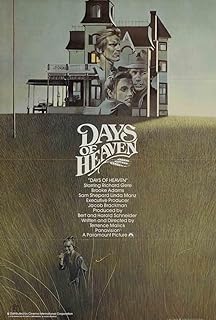電影訊息
電影評論更多影評

2012-04-30 00:09:24
愛上20世紀初的美國農場
每每觀影結束,個人習慣是看片名與內容一致或相關不?好比對於這部,就感到困惑。
如果是說男女主又或只是女主以及小女孩在農場停留的那段日子,為何不好好珍惜?經男主之口,女主逐漸愛上了農場主。所以,觀者如我,會把「天堂之日」的喪失歸咎於男主為一己私慾。如果愛她,就放手,讓她不用跟著受顛簸流離之苦。所以,比之理查基爾塑造的眾多角色,如前段日子重溫過的《風月俏佳人》,我很不喜歡這部中背負兩條命案的傢伙,很高興他為此付出了代價。
從片中提到的威爾遜總統及結尾女主跳上開赴歐洲戰場的火車,大致可以把影片講述時間限定在20世紀第二個十年。難道麥田收割還在沿用片子展示的那種方式嗎?機械化程度遠沒有達到想像中的高度。
記不起是讀高中還是初中那會,英語課本中有一篇課文是說鹽湖城的蝗災的。一直想像發生時會是怎樣一副畫面,影片呈現了出來。當然,還有麥田大火,想到基努李維斯主演的《雲中漫步》中納帕河谷一處葡萄園的夜晚大火。
不喜歡影片講述的故事。不過,對鏡頭下的農場的一切都大愛,麥田裡的野雞(?),以及其它動物,農莊周圍的地形,有山、有河,等等。
【幕後製作】:《天堂的日子》由長期在法國為特呂弗掌鏡的攝影師阿爾曼德羅(Nestor Almendros)拍攝,影片以舒緩的格調、油畫式的構圖和色調,準確地捕捉了世紀初的美國田園風味。結尾農場主在捕殺蝗蟲時為宣洩心中的情感而放火怒燒麥田的場景,更顯示影片在攝影技術方面所作出的傑出的貢獻。全片幾乎全是外景,而且大多是在所謂「魔術時刻」——即每天在日出前、日落後各半小時左右,天空轉為深藍或紅色,但仍可清楚照映出大地上所有景物的輪廓,看起來像是從天空架設燈光,再照到地面的效果,攝影界稱之為「魔術時刻」——拍攝,頗收油畫與剪影之功效。影片中那晚霞映照下空曠田野裡的稻草人、沾滿露水的麥穗、晨曦中麥田裡勞作的農民、天空中南飛的雁群、亂風吹皺湖面泛起的陣陣漣漪,光與影美不勝收,俯拾皆是,《天堂的日子》成為每個研究電影攝影者必看的影片。
【P.S.】:The seagulls of Salt Lake City
Salt Lake City is a beautiful city in the west of North America, which was founded over a hundred years ago. At that time, a group of men, women and children arrived at a valley with high mountains all around it. They had traveled a long way. They had begun their journey far away in the east. After they had crossed the mountains, they found the valley. In the middle of it there was a salt lake. This was where their city now lies.
The land seemed good, and they decided to stay there. They built their homes, and made their farms, and planted their crops. The people had to work hard on their farms. If they did not grow enough food, they would have nothing to eat.
One day while they were working in the fields, some farmers saw something strange in the sky. 「what is that?」 asked one of them .
「Where?」 asked another farmer, as he stopped to look.
「Over there ,」he answered.
They saw something coming towards them. It looked like a cloud, but it was too low in the sky. As they watched, it came nearer and nearer. Suddenly a shout went up: 「Locusts! Millions of locusts!」
Every one stopped working, and looked at the sky. They were all frightened, because they knew what locusts could do. They had never seen so many of them before.
In no time the locusts came down and started eating their crops —the wheat, the vegetables, even the grass, and the leaves on the trees.
Everyone—men, women and children—tried to fight against the locusts. They tried everything , but while they were killing locusts in one place, millions more arrived in another.
What could they do?
Suddenly they heard a great noise. They looked up into the sky and saw another great cloud coming towards them. To their surprise, they saw not locusts, but seagulls. The farmers cried out, 「They have come to eat what the locusts have left!」
But they found that the seagulls had come to eat, not their crops, but the locusts. Usually, the seagulls lived near the sea. But they had seen or smelt the locusts and had come to eat them. Now they were eating the locusts. In a short while they ate up millions of them. The farmers』 crops were saved!
The people were very thankful. They decided that from then on no one should ever kill a seagull . And today, if you go to Salt Lake City, you can see a monument with seagulls on top of it.
評論

